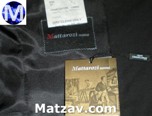 By Meir Goldenson, The Shatnez Lab of Beitar
By Meir Goldenson, The Shatnez Lab of Beitar
An importer brought into Israel about 5,000 suits to be distributed for free through a yeshiva system to poor students. Some were also sold to those who could afford to purchase new suits. He said that he had a sample of suits tested in the shatnez lab in Bnei Brak and they were found to be shatnez free. Therefore, he told the recipients that they could wear the suits and did not need them to be checked.
An astute resident in Beitar brought the suit to the shatnez lab of Beitar for testing, because she is very much aware that
one cannot rely on a sample. I found a piece of fabric containing white linen threads in one direction. The scrap of fabric was used
as a re-enforcement at the top of the front darts. The suit is Mattarozi Uomo, made in China. The one I checked states 70% wool and 30% polyester. Other suits list different percentages of wool up to 100% wool.
The customer was so concerned about this find, since she heard from many other parents that they had no intention of getting their son’s suits checked that she got back to the importer with this issue. The importer contacted us to confirm that we had found shatnez and took a number of additional suits to the lab in Bnei Brak, since that is where he has his business.
The yeshiva system sent out word to all the recipients that this problem exists in these suits and they could not be worn before they were checked for shatnez. Since this warning was issued, about 25% of the suits that were brought for checking have been found to contain this piece of material with linen in it.
Again, this emphasizes the need to check all suits and not rely on the word of a storeowner or distributor that all the suits are shatnez-free because the samples tested were shatnez free. It is a neis that this was found just days before Pesach. It saved many from the issur of shatnez.
{Meir Goldenson-Matzav.com Newscenter}












One should only use a qualified Shatnez Lab that is affiliated with the International Shatnez testers Organization. They all receive current updated information re: latest findings of Shatnez from over 100 testers across the globe.
Meir Goldstein of Beitar is affiliated with the International Shatnez Testers Org.
I don;t know the details of this case, not of Meir Goldstein. But this fits a frequent pattern, expecially with reagrd to Shatnez where one group has undertaken to question another (I am unafilliated with either one), and uses public “alarms” and “crises” without basis in halachah.
One should consult with his own qualified poseik to determine if this is actually a problem.
The Torah gives guidelines for the dinim of when “rov” “chazakah” may apply. People should not base halachah only on those well-meaning individuals or groups who are well-versed in “metzius” but have limited understanding of the halchahic background.
The Rishonim and Acharonim (for instance, see Rosh regaring bittul, Rema and Aruch Hashulchan regarding olive oil) denounce those who do recognize, or “who know better than” or “are frummer than” the klalim of chazal.
Being “machmir” is sometimes not a chumrah, it’s stupidity or worse — to quote the Rosh — Kefirah.
I have always been told by shatnez checkers that you can’t rely on any chazakos for shatnez yet they themselves always do .When you check a collar they look for the area around the opening how do they know what’s doing at the other end of the collar obviously its not practical to look through the whole collar but surely its possible though not likely that at the other end there is shatnez for that they rely on a chazaka at the same time a suit that was sold at the right place 1000 times and was shatnez free must be checked sounds like someone wants to make as much money as possible.
I’m with Reality Check. You can’t write an article about “Why relying on sample testing for shatnez is no good” and not quote even one halachic source.